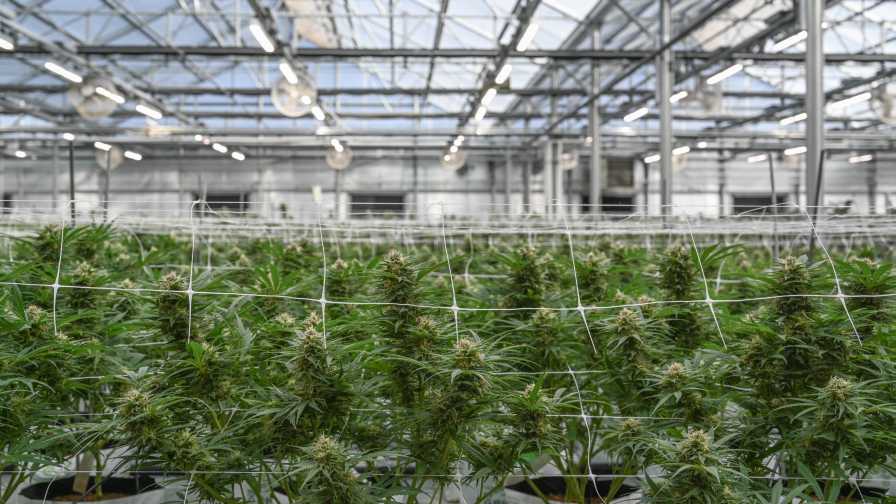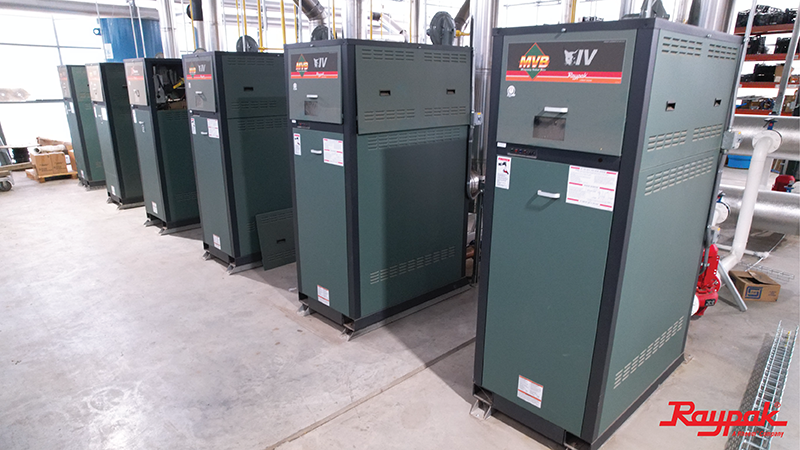Lessons All Growers Can Learn From the Cannabis Gold Rush

Photo courtesy of Fluence by OSRAM
When cold-frame greenhouses and outdoor spaces are not viable for crop production, climate-controlled greenhouses can maximize cultivation activity. The cannabis industry has much to learn from commercial agriculture, and high profit margins and deep levels of investment in facilities have also resulted in mutually beneficial lessons learned for growers of other crops.
Cannabis demands a tightly controlled environment and continuous production, which leads to a high cost of downtime and a high return on investment for efficiency. Producers in many regions find greenhouses to provide a lower-cost alternative to indoor grows that offer a similar amount of environmental control.
Resource Innovation Institute is a non-profit organization committed to cultivating a better future for all of humanity. Our consortium of members brings perspectives from across the field — uniting architects and engineers, growers and operators, researchers and analysts. Together, we lead the measurement, adoption, and celebration of the world’s most efficient agricultural ideas. In this article, RII’s Technical Director and members of the organization’s Technical Advisory Council working groups share lessons learned in cannabis production that may be applied to commercial agriculture.
Cash Crop
In emerging legal, commercial cannabis markets, the average price per pound can exceed $3,500 per pound. In mature markets, wholesale prices of greenhouse-grown cannabis still range between $1,150 to $1,300. With considerable revenue available for reinvestment, growers can install and test efficient equipment in their facilities.
Look to cannabis facilities for inspiration when designing high-performance racking, lighting, HVAC, and irrigation setups. Improve productivity by learning from the benefits cannabis producers have found when using greenhouse glazing, LED supplemental lighting, hydronic bench heating systems, and automated shade and curtain systems.
Glaze for Success
Greenhouse glazing systems are the stewards of plant health and vitality, interacting with the natural environment to protect and nourish your plants.
Technical Advisory Council member GDS Associates recommends balancing infiltration rate, insulating value, light transmission, and longevity.
“When looking at climate-controlled greenhouses, cannabis, or tomatoes, optimizing the building envelope is key,” says Program Manager Bethany Reinholtz, who suggests the following:
- Infiltration – Glass has a high light transmission rate, and a very high infiltration rate and a low insulation value. Learn more about sealing the envelope in our March Greenhouse Grower article.
- Insulation – Some greenhouse coatings have low insulation values, such as single pane glass (U-1.1), while others will have a much higher insulation value, such as 6-layer polycarbonate (U-0.27). Consider adding perimeter insulation to a depth of at least 2 feet, insulating opaque surfaces of north end walls, and insulating knee walls. Insulating knee walls is especially doable as cannabis is generally not grown on the ground and light is not needed at that level. “Utilization of insulated drop-down sidewall curtains can save additional energy at night and decrease light pollution from nighttime light use,” Reinholtz says.
- Light Transmission – Higher transmissivity glazing materials can decrease greenhouse supplemental lighting needs. Some greenhouses with specialized coatings allow natural light to achieve target light levels during parts of the year without using any supplemental lighting.
- Longevity – Cannabis growers typically grow year-round to maximize productivity and consistency. Glazing with longer lifespans allows for continuous growing and perpetual harvests. Some greenhouse materials, like films, need to be replaced every four to five years, while others can last up to 20 years (such as polycarbonates and acrylics). Glass can last even longer, which minimizes operational downtime. Consider the life-cycle cost of your building envelope and how maintenance (like cleaning, repairs, and replacements) will be performed.
Get Consistent Growth with LED Lighting
Many high-value crops grown in greenhouses can be enhanced with additional light, and some regions need to supplement natural light to achieve target photoperiods for plants. Technical Advisory Council member Zartarian Engineering & Precision Ag notes the demand from the cannabis industry for quality sole-source and supplemental LED lighting solutions has blown the market wide open. Dozens of new companies now compete against each other to make the best light recipes with the highest efficacies, while gaining the trust of growers to move on from their high-pressure sodium lamps.
Some cannabis growers optimize production by using high-density indoor nursery approaches for early growth cycles, where propagation can be more economical.
“Get better, more consistent starts by growing young plants indoors to accelerate growth with more control before moving to the greenhouse,” recommends Principal Mike Zartarian. “Greenhouse operations in areas where land costs are higher may benefit from focusing on late vegetating and flowering plants.”
When choosing sole-source lighting solutions for propagation, Zartarian says to consider broad-spectrum white light recipes, which are great for plants and humans.
Five years ago, the horticultural LED market was described as the Wild West. In 2021, there are standards, qualified product libraries, and incentives from efficiency programs. Organizations have developed testing protocols and technical requirements for manufacturers to meet to certify products for listing. Today, more than 60 utilities across North America support growers with programs in 11 regulated cannabis markets. Commercial agriculture businesses can ride this wave and take advantage of free technical assistance and financial support to buy down the cost of efficient lighting equipment.
Bring the Heat to the Root Zone
Cannabis growers find that root zone heating usually allows greenhouse air temperatures to be reduced by 5 degrees or more. Research has shown hydronic bench heating systems can improve growth in some crops, including tomatoes.
Use floor or under bench heating systems to decrease space heating needs. Floor and bench heating systems save heat by losing less heat to the upper ridge of the greenhouse, where nothing grows. Heating the area under plants has a side benefit of allowing for easier installation of thermal curtains.
Automate Control Systems
Most cannabis facilities are smaller than the typical greenhouse used for commercial agriculture. More simple, cost-effective controls options are widely available for smaller growers of all crops as an alternative to massive enterprise greenhouse-type systems. Equipment prices are dropping for sensors and cameras. More zones with finer control are all more economically within reach for greenhouse growers.
Energy screens and shade curtain systems are a cost-effective application of automation for greenhouse producers, which significantly decrease nighttime heat loss, provide shade, and decrease cooling loads on hot sunny days. Competitive cannabis greenhouses use automated light deprivation systems to achieve optimal photoperiods every day of the year.
When used in conjunction with controls, light deprivation/shade curtain systems and LED lighting can provide precise intensity and day length of light to greenhouse crops. This technique has broad applications across greenhouse crop strategies, helping to extend seasons and allow for different cultivation tactics from an existing facility. Since light deprivation is almost universal in cannabis-controlled envelope greenhouses, these solutions are now available in many more sizes and at a lower cost than before for commercial producers of all crops.
Greenhouse growers of all crops can use technology to improve facility productivity in many ways by upgrading building envelopes, using LED lighting and hydronic bench heating, and automating any and all systems to integrate for efficiency.
Keep an eye out for additional tips in Resource Innovation Institute’s next peer-reviewed Best Practices Guide on Automation & Controls for Cannabis Producers coming in July. Consider benchmarking your greenhouse operation with PowerScore. Dig deeper by joining RII and participating in our Technical Advisory Council working groups.
More Information on the Sources
Mike Zartarian is the Principal of Zartarian Engineering & Precision Ag in Boston, MA. He attended Northeastern University earning a BS and MS in Electrical Engineering, and spent the first part of his career designing speaker systems and audio electronics for performing musicians. The switch to precision agriculture came naturally, and he has worked on a wide variety of projects in both cannabis and vegetable production, focusing on LED systems, sensors, power systems, and facility design. He is equal parts engineer and cultivator, designing equipment, processes, and facilities for the cannabis and commercial ag industries. He is an active member of Resource Innovation Institute’s Technical Advisory Council and helped develop RII’s Controls Best Practices Guide with the 2021 Controls Working Group.
Bethany Reinholtz is a project manager with GDS Associates, Inc. and brings more than 12 years of experience working on agricultural energy management plans, GHG reductions, energy efficiency, and renewable energy feasibility studies. She conducts agricultural program implementation, planning, evaluation, and special studies for clients such as the Colorado Energy Office, NYSERDA, and the Minnesota Department of Commerce. She is nationally recognized for her expertise related to beneficial electrification in the agriculture sector and has specialized expertise in controlled environment agriculture. Bethany was also part of the team that developed web-based agriculture energy analysis tools for public use. She recently completed a comprehensive Study of Energy Efficiency and Renewable Energy potential in the agriculture sector in Minnesota. Bethany solves problems related to agricultural energy efficiency and renewable energy for government entities, utilities, and farms of all types and sizes.









